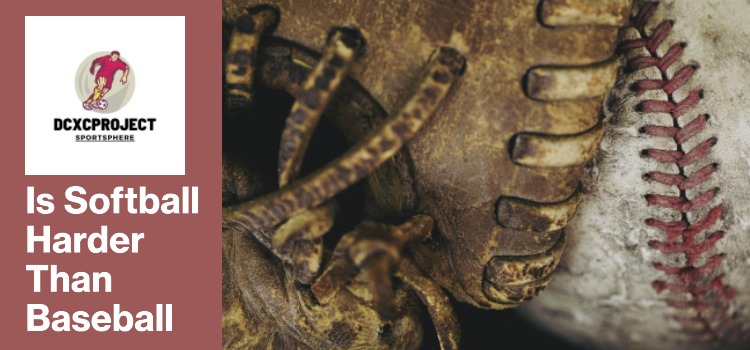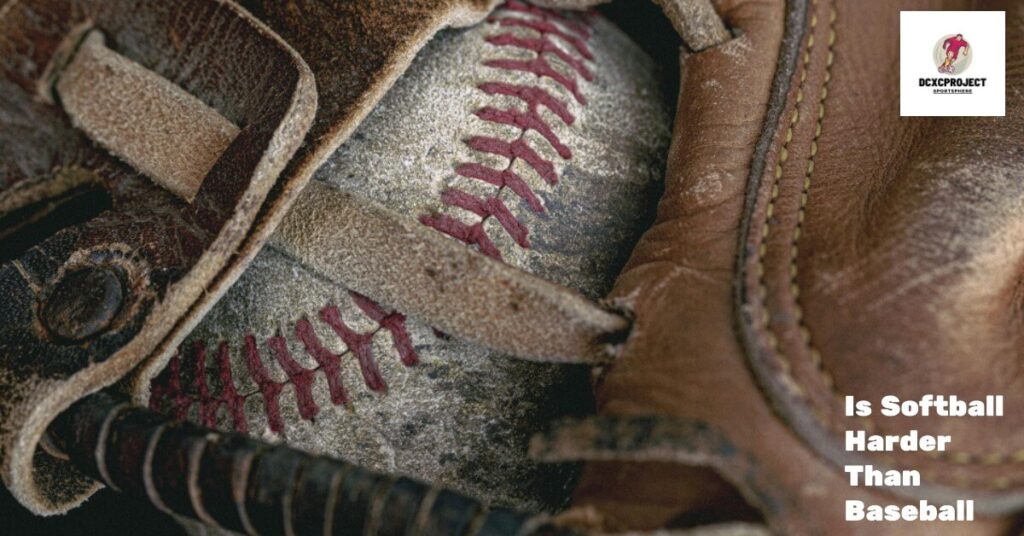In the world of sports, comparisons are inevitable. One such comparison that often sparks heated debates is: Is softball harder than baseball? This question may seem simple on the surface, but it delves into the heart of two sports that, while similar, have distinct differences that can significantly impact the level of difficulty.
Debating whether softball is harder than baseball involves comparing various aspects of both sports. Softball features underhand pitching, which can be faster and offer less reaction time, despite the pitcher being closer. On the other hand, baseball usually involves overhand pitching, with higher speeds but from a greater distance.
The softball is larger and theoretically easier to hit, but the differing pitching techniques can complicate this perception. Each sport requires different skill sets and strategies, meaning the difficulty is often subjective and based on personal experience. Factors like agility, speed, and coordination play critical roles in both games, making the comparison a topic of ongoing discussion among athletes and enthusiasts. This debate continues as players at all levels enjoy the unique challenges and rewards presented by each sport.
Understanding The Origins Of Softball And Baseball
Exploring the historical backdrop of softball reveals its late-19th-century inception, distinct yet intertwined with baseball’s evolution. Debates often center on the difficulty level of softball versus baseball, with pitch speeds and ball sizes contributing to the complexity of comparison.
Historical Background Of Softball And Baseball
Differentiation In Rules And Gameplay
| Aspect | Softball | Baseball |
|---|---|---|
| Ball Size | 11 to 12 inches in circumference | 9 inches in circumference |
| Field Dimensions | Smaller fields; distance from pitcher’s mound to home plate typically 43 feet (women’s) | Larger fields; 60.5 feet from pitcher’s mound to home plate |
| Pitching Style | Underhand pitch | Overhand or sidearm pitch |
| Game Length | Usually 7 innings | Typically 9 innings |
| Bat Size | Generally shorter and lighter | Typically longer and heavier |
Comparing The Athletic Requirements
Welcome to the heart of the debate between softball and baseball enthusiasts: the athletic requirements of each sport. While both games share fundamental similarities, they demand unique physical abilities from their players. Diving into the specifics of speed, agility, reaction time, physical endurance, and strength reveals the intricacies and challenges players face on the diamond.
Speed, agility, and reaction time in softball and baseball
Speed, Agility, And Reaction Time In Softball And Baseball
- Softball speed: Shorter bases (60 feet) mean baserunning relies on quick jolts of speed.
- Baseball speed: With bases 90 feet apart, players need sustained speed to successfully steal bases or chase down balls.
Physical endurance and strength needed for each sport
Physical Endurance And Strength Needed For Each Sport
| Sport | Endurance Needs | Strength Focus |
|---|---|---|
| Softball | Higher intensity for shorter durations | Core, lower body, shoulder stability |
| Baseball | Steady endurance for longer periods | Upper body, arm and leg strength |

Evaluating The Psychological Aspects
Examining the psychological factors reveals intriguing complexities in the softball versus baseball debate. Mental toughness and strategic thinking are crucial, as players navigate the nuanced differences between the two sports, impacting perceived difficulty levels.
Decision-making And Strategy In Softball And Baseball
Both softball and baseball players must exhibit sharp decision-making skills and strategic thinking. The speed and compactness of a softball game demand quick reflexes and instant judgment calls. Players analyze the situation, predict their opponents’ moves, and make split-second decisions that can change the game’s outcome.
- Pitch selection: Choosing the right pitch or anticipating one involves understanding the opponent’s strengths and weaknesses.
- Field positioning: Players must be mentally prepared to adjust their position with each hit and anticipate where the play might develop.
- Base running: Quick judgment on whether to advance or stay put can decide the momentum of the game.
Concentration And Focus Under Pressure
| Aspect | Softball | Baseball |
|---|---|---|
| Decision-making Speed | Instant | Strategic |
| Game Pace | Rapid-fire | Measured |
| Focus Type | Continuous Sprints | Endurance Marathon |
Ultimately, while the psychological demands of softball and baseball present different challenges, each requires a unique blend of quick thinking, strategic insight, and unyielding focus. Players of both sports navigate these mental challenges differently, shaped by the distinctive rhythms and rules of their respective games. Recognizing and honing these psychological skills are as critical to success as the ability to pitch a strike or hit a home run.
Unveiling The Technical Proficiency
Exploring the debate, ‘Is Softball Harder Than Baseball’ unveils a realm of technical skills and dexterity. Softball’s unique pitching style and gameplay intricacies command a high skill level, challenging the assumption of its comparative difficulty to baseball.
Batting: A Swing Comparison
- Baseball Batting Skills:
- Explosive swing power
- Precision timing
- Deep ball tracking
- Softball Batting Skills:
- Adjustment to pitch arc
- Quick reflex adaptation
- Bunt and slap-hitting proficiency
Pitching: A Duel Of Speed And Strategy
| Baseball Pitching | Softball Pitching |
|---|---|
| Extended range of motion | Wrist snap precision |
| Developing pitch variety | Crafting pitch deception |
| Mental fortitude for speed control | Accuracy under constrained distance |
Fielding: Agility Across The Diamond
- Baseball Fielding Drills:
- Long toss for arm strength
- Ground ball techniques
- Pop fly communication exercises
- Softball Fielding Drills:
- Short-burst agility circuits
- Quick release practice
- Infield teamwork coordination
Training Methods And Drills For Skill Enhancement
- Technique-Driven Drills: Emphasizing fundamentals through repetitive skill exercises.
- Strategic Weight Training: Tailored to strengthen muscle groups most engaged in the player’s respective positions.
- Video Analysis: Allows detailed breakdowns of mechanics for both personal performance and studying opponents.
- Mental Conditioning: Develops focus and psychological resilience under pressure.
Both sports offer unique challenges that test the limits of an athlete’s capabilities. Whether it’s blasting a fastball over the fence or adeptly maneuvering a quick infield play, the journey to mastery in softball and baseball is one of relentless pursuit and fine-tuned technical proficiency.
Exploring The Competitive Elements
Understanding the intricate dynamics of softball versus baseball reveals unique challenges. Delving into softball’s condensed playing field and faster pace highlights its rigorous nature, inviting comparisons to its counterpart sport, baseball.
Level Of Competition In Softball And Baseball
| Metric | Softball | Baseball |
|---|---|---|
| Scholarships Available | 12 per team | 11.7 per team |
| Team Participation | Over 1,600 varsity teams | Over 1,800 varsity teams |
| Individual Player Stats | Varies widely | Varies widely |
Challenges Faced By Athletes In Each Sport
- Pitching: Softball’s underhand pitch requires impeccable precision and speed, making it a complex skill to master. Baseball’s overhand throws allow for a wide range of pitches, which can be equally as difficult to perfect.
- Batting: Due to softball’s smaller field and faster pitch speed, batters have less time to react, demanding quick reflexes. Conversely, baseball players face a larger field and varied pitch styles, challenging their timing and technique.
- Fielding: Agility and reaction time are crucial in softball, with plays unfolding rapidly. Baseball’s larger field and longer bases create different demands for fielding, such as strength for longer throws.
- Game Strategy: Both sports require athletes to have a deep understanding of the game’s strategy. From knowing when to steal a base to executing the perfect bunt, intellectual prowess is just as important as physical skill.

Frequently Asked Questions On Is Softball Harder Than Baseball
Why Is Softball Better Than Baseball?
Softball offers a faster-paced game than baseball, with shorter distances between bases leading to more action. The sport emphasizes team cohesion and can be more inclusive for players of different ages and skill levels, making it accessible and enjoyable for a broad audience.
Does It Hurt More To Get Hit By A Softball Or Baseball?
Getting hit by a baseball typically hurts more due to its harder composition and higher velocity. Softballs are softer and larger, causing less impact.
Does Baseball Take More Skill Than Softball?
Baseball and softball both require high skill levels; comparing them is subjective. Skill demands differ rather than one being more skill-intensive than the other.
What Is Harder A Softball Or Baseball?
A baseball is generally harder than a softball. The core of a baseball is made of cork, rubber, or a blend, and its tight wound structure contributes to its hardness. Softballs have a softer core, usually made of polyurethane or similar materials.
Conclusion
Wrapping up, the debate on softball versus baseball hinges on personal perspectives. While skill sets and athletic requirements differ, both sports demand dedication and physical prowess. Ultimately, whether softball is harder than baseball is subjective; players and fans alike hold their own truths.
Embrace each game for its unique challenges and rewards.

